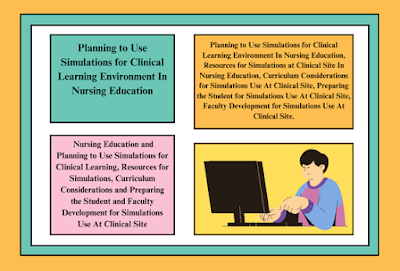Development for Simulations Use At Clinical Site 1. Strategic Planning for Simulations
Effective use of simulations in nursing education requires thorough planning. Key considerations include:
- Resource Allocation: Identify the necessary resources, including physical space, equipment, and technology.
- Curriculum Integration: Align simulations with the overall curriculum and course objectives.
- Student Preparation: Ensure students are adequately prepared for simulation-based learning.
- Faculty Development: Train faculty to effectively use and facilitate simulations.
Resources for Simulations at Clinical Sites
1. Physical Space and Equipment
Operationalizing simulations requires:
- Adequate Space: Ensure there is sufficient room for teaching, learning, faculty offices, equipment storage, debriefing, and video recording if needed.
- Simulation Equipment: Utilize a variety of equipment and technology, such as manikins, virtual reality, electronic health records, and audiovisual tools.
2. Support Staff
- Technical Support: Employ staff to manage and maintain simulation equipment and technology.
- Simulation Facilities: Well-resourced spaces should replicate real clinical settings, like acute care environments or operating room suites.
Curriculum Considerations for Simulations
1. Needs Assessment and Analysis
- Curriculum Alignment: Conduct a needs assessment to understand how simulations fit into the broader curriculum and intersect with clinical site placements.
- Competency and Standards: Integrate QSEN competencies, national patient safety goals, the NCSBN Licensure Examination blueprint, and Institute of Medicine initiatives into simulation design.
2. Schematic Design
- Course Objectives: Develop a schematic design for each course, ensuring that simulation aligns with theoretical knowledge, clinical practice, and learning goals.
Preparing Students for Simulations
1. Student Orientation
- Equipment Familiarization: Orient students to simulation equipment and their roles as active learners.
- Learning Goals: Clearly outline the learning objectives, required assignments, and the relevance of simulations to clinical practice.
- Assessment Expectations: If simulations are used for evaluation, provide clear rubrics and opportunities for students to practice with the equipment.
2. Benefits of Simulations
- Flexible Learning: Simulations offer flexible, accessible opportunities for skill practice outside traditional class hours.
- Safe Practice Environment: They provide a safe space for repeated practice and exposure to real-life clinical scenarios, enhancing confidence and competence.
Faculty Development for Simulations
1. Evolving Faculty Roles
- Facilitator Role: Shift from a traditional teacher-centered approach to a student-centered, facilitative role during simulations.
- Simulation Management: Faculty must support learners throughout simulations and facilitate debriefing sessions.
2. Training and Support
- Pretraining: Provide pretraining on simulation pedagogy and debriefing techniques to ensure faculty are comfortable and competent.
- Orientation Courses: Develop or participate in orientation courses to learn about simulation design, technology use, and debriefing methods.
- Continuous Support: Offer ongoing support to faculty, including assistance with simulation design and equipment setup.
3. Addressing Challenges
- Novice Faculty Support: Assist new faculty in operationalizing critical thinking objectives through structured guidance and questions (Whei Ming & Juestel, 2010).
- Experience Sharing: Encourage faculty to experience simulations firsthand through orientation courses to better understand the process and their role.
